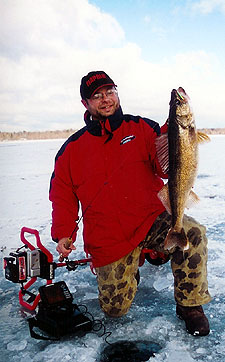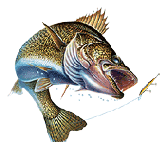|
January Ice
by
Mark Martin
It’s often said that walleyes are
walleyes wherever they swim. True for the most part, but one of the few times there’s
a noticeable difference between populations is when ice
fishing—specifically, when you compare walleyes from inland waters
with their big-water brethren of the Great Lakes. Although similar
locational principles apply wherever you fish, the techniques with
which you catch ice walleyes had better be supersized on Lake Erie,
Saginaw Bay and the Bays de Noc. Away from the inland seas, subtle
is the way to go.
they swim. True for the most part, but one of the few times there’s
a noticeable difference between populations is when ice
fishing—specifically, when you compare walleyes from inland waters
with their big-water brethren of the Great Lakes. Although similar
locational principles apply wherever you fish, the techniques with
which you catch ice walleyes had better be supersized on Lake Erie,
Saginaw Bay and the Bays de Noc. Away from the inland seas, subtle
is the way to go.
In a way, inland vs. Great Lakes
walleyes represent a tale of two fishes. Through the ice on lakes
and reservoirs, it’s hard to beat little lures with a piece of bait
or a small minnow. On the big water, you can gob up a spoon or a
Jigging Rapala with a minnow—a pretty big one, at that—on every
hook. Big-time predators, open-water fish accustomed to mowing down
shad and alewives, simply like it large. This winter, paying
attention to the walleye’s tendencies and giving them what they want
are going to mean more fish.
Drill, Baby, Drill
Wherever you fish, it’s important to drill your holes and make your
noise as quickly as possible. To get a spread of holes that allows
me to fish shallow, deep and in between, I burn holes in the ice
with a Strike Master Lazer Ultra Mag, a three-bladed power auger
with a chisel tip and a two-horsepower Tecumseh engine. All told,
the auger weighs just 26 pounds—just the kind of portability and
capabilities necessary to turn the ice into Swiss cheese. When the
ice is glare, without a thick carpet of snow to provide traction,
the chisel tip comes in handy to drill holes easily, and it lets you
efficiently put two holes together when fishing the Great Lakes.
That’s where you had better have a big opening in the ice to pull
out trophy walleyes.
On that glare ice—or anywhere
slippery—Strike Master’s Get a Grip treads provide traction without
tearing up shanties or even the inside of a truck. The Get a Grip
Advanced ice treads slide over boots or shoes and are made with
carbide spikes that won’t slice whatever you’re walking on. They
just give a great foothold for ice fishing.
To keep tackle organized, pick up a
Plano 4600 Guide Series box, a clear-plastic piece of storage that,
at 11 inches long, will fit in the pocket of a parka. For something
smaller and waterproof, there’s the Plano 3500 with an O-ring around
the edge to keep out moisture. Another favorite is the Northland
Tube-It, a tackle tote that hangs around your neck and has small
plastic tubes to hold terminal tackle and important jigs and lures.
Between the traction and the
auger—to say nothing of great tackle to try—it’s up to you to drill
as many holes as possible over productive water. For starters, I
look for large, flat areas near some current—prime feeding
territory. It’s important that the flat is near deep water so the
walleyes don’t have to roam far to feed. When punching holes, I put
them out in the depths over soft bottom, on the edge of the drop and
atop the flat. Even better is hard bottom such as gravel atop the
feeding flat.
Whether I’m on inland waters or the
Great Lakes, I rely on electronics to find key areas. On inland
waters, I might take my GPS coordinates from open-water fishing to
pinpoint a rock pile or a gravel patch on a point. If I’m on bigger
water, I’ll go into the garage and power up my Lowrance Global Map
unit, with its electronic multimedia chips that contain contour
lines on the water I’m fishing, and scroll around until I find
places I’ve caught fish near key breaklines. I’ll also pay attention
to hard bottom or sharp turns, write down the GPS coordinates and
then go out with a hand-held unit to find the spot on the spot below
the ice. With Fishing Hot Spots Hot Maps, which install in Lowrance
units, or on the company’s CD-Rom units for personal computers, I’ll
check for wrecks, too—a key fish-holding area in winter. On big
water like the Great Lakes, a wreck near a two-foot drop is often
enough to concentrate winter walleyes. Combine the edge of hard and
soft bottom with a little bit of current, and you’re in business.
Another option is green weeds. The
brown ones that are dying give off carbon dioxide—not the right
choice. But when weeds are green, they give off oxygen and hold bugs
and baitfish, which in turn attract walleyes. Just be sure not to
drop an offering too far down into the weeds; elevate it just enough
to stay above the weeds, where the walleyes move in to feed.
Small or Supersized?
Now comes the time to trigger the fish. On inland waters, I always
downsize my offerings. Instead of a No. 5 jigging Rapala, I opt for
a smaller No. 3. The reason is that you’re dealing with smaller
baitfish and less-aggressive walleyes than the Great Lakes predators
that chase down big mouthfuls over vast stretches throughout the
year. Likewise, I’ll downsize with lighter line—say, six-pound
test—and incorporate a subtle second rod. While I jig a Rap or a
spoon, I’ll have a dead rod with a Northland Fire-Ball jig or a
simple plain hook with a split shot with a minnow. (Check out the
new colored split shots, called Hot Spots, from Northland.) That
second rod will often catch the fish that come in for a look at the
jigging lure but opt for a minnow that’s just sitting there.
(Time out for a tip: Be sure to
put a Berkley ball-bearing swivel about 18 inches above the Rap, or
any other spoon or jig, to eliminate line twist. Also, attach the
Rap or a spoon with a small Cross-Lok snap to give the lure the
freedom to work.)
Okay, back to the action. Other lure
choices when I’m inland are Northland’s Fire-Eye, a cross between a
jig and a spoon, and the Forage Minnow, another crossover that sits
horizontally in the water. The Forage Minnows come in holographic
colors, which is important in clear water. In clear water, I like
colors such as holographics or black and silver or blues. If the
water has more stain, I’ll switch to firetiger and bright orange. It
never hurts, either, to add a little bit of scent—perhaps some Dr.
Juice—for inland or Great Lakes walleyes.
|


 they swim. True for the most part, but one of the few times there’s
a noticeable difference between populations is when ice
fishing—specifically, when you compare walleyes from inland waters
with their big-water brethren of the Great Lakes. Although similar
locational principles apply wherever you fish, the techniques with
which you catch ice walleyes had better be supersized on Lake Erie,
Saginaw Bay and the Bays de Noc. Away from the inland seas, subtle
is the way to go.
they swim. True for the most part, but one of the few times there’s
a noticeable difference between populations is when ice
fishing—specifically, when you compare walleyes from inland waters
with their big-water brethren of the Great Lakes. Although similar
locational principles apply wherever you fish, the techniques with
which you catch ice walleyes had better be supersized on Lake Erie,
Saginaw Bay and the Bays de Noc. Away from the inland seas, subtle
is the way to go.